No results for 'b.a. economics honours' in combination with the chosen filters.
What to do next?
Perhaps you are looking for ...
All 13 results
Sort by
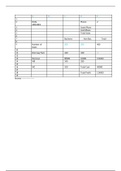
-
Title Price vs Capacity Problem On an air rout, an ailine offers two classes of service: busienss (B) and Description Price vs Capacity Problem On an air rout, an ailine offers two classes of service: busienss (B) and economy (E) The respective demands ar
- Class notes • 1 pages • 2020
-
- $7.49
- + learn more
Price vs Capacity Problem On an air rout, an ailine offers two classes of service: busienss (B) and Description Price vs Capacity Problem On an air rout, an ailine offers two classes of service: busienss (B) and economy (E) The respective demands are given by: For B – P= 540-5Q For E – P= 380-25Q Because of ticketing restrictions business travelers cannot take advantage of economy’s low fare The airline operates two flights daily Each Flight has a capacity of 200 passengers The cost per fl...
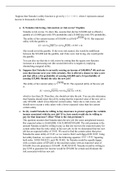
-
Suppose that Natasha’s utility function is given by u (I) = 110I, where I represents annual income in thousands of dollars. a. Is Natasha risk loving, risk neutral, or risk averse? Explain. b. Suppose that Natasha is currently earning a
- Answers • 1 pages • 2020
-
- $4.49
- 1x sold
- + learn more
Suppose that Natasha’s utility function is given by u (I) = 110I, where I represents annual income in thousands of dollars. a. Is Natasha risk loving, risk neutral, or risk averse? Explain. b. Suppose that Natasha is currently earning an income of $40,000 (I = 40) and can earn that income next year with certainty. She is offered a chance to take a new job that offers a .6 probability of earn- ing $44,000 and a .4 probability of earning $33,000. Should she take the new job? c. In (...
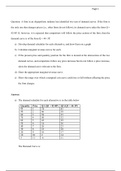
-
Question: A firm in an oligopolistic industry has identified two sets of demand curves. If the firm is the only one that changes prices (i.e., other firms do not follow), its demand curve takes the form Q = 82-8P. If, however, it is expected that competit
- Answers • 4 pages • 2020
-
- $3.99
- 1x sold
- + learn more
A firm in an oligopolistic industry has identified two sets of demand curves. If the firm is the only one that changes prices (i.e., other firms do not follow), its demand curve takes the form Q = 82-8P. If, however, it is expected that competitors will follow the price actions of the firm, then the demand curve is of the form Q = 44 -3P. a) Develop demand schedules for each alternative, and draw them on a graph b) Calculate marginal revenue curves for each. c) If the present price and quantity ...
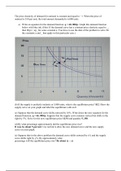
-
The price elasticity of demand for oatmeal is constant and equal to −1. When the price of oatmeal is $10 per unit, the total amount demanded is 6,000 units. a) Write an equation for the demand function. q = 60, 000/p. Graph this demand function below wit
- Answers • 1 pages • 2020
-
- $3.49
- + learn more
The price elasticity of demand for oatmeal is constant and equal to −1. When the price of oatmeal is $10 per unit, the total amount demanded is 6,000 units. a) Write an equation for the demand function. ------------. Graph this demand function below with blue ink. (Hint: If the demand curve has a constant price elasticity equal to _, then D(p) = ap_ for some constant a. You have to use the data of the problem to solve for the constants a and _ that apply in this particular case.) (b) If the s...
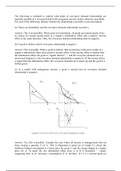
-
The following is intended to explore what kinds of own-price demand relationships are logically possible in a two-good model with exogenous income (unless otherwise specified). For each of the following, indicate whether the relationship is possible or no
- Answers • 2 pages • 2020
-
- $2.99
- + learn more
The following is intended to explore what kinds of own-price demand relationships are logically possible in a two-good model with exogenous income (unless otherwise specified). For each of the following, indicate whether the relationship is possible or not and explain: (a) Tastes are homothetic and the own-price demand relationship is positive. (b) A good is inferior and its own-price relationship is negative. (c) In a model with endogenous income, a good is normal and its own-price demand rel...
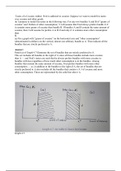
-
Tastes of a Cocaine Addict: Fred is addicted to cocaine. Suppose we want to model his tastes over cocaine and other goods. A: I propose to model his tastes in the following way: For any two bundles A and B of “grams of cocaine” and “dollars of other cons
- Answers • 3 pages • 2020
-
- $2.99
- + learn more
Tastes of a Cocaine Addict: Fred is addicted to cocaine. Suppose we want to model his tastes over cocaine and other goods. A: I propose to model his tastes in the following way: For any two bundles A and B of “grams of cocaine” and “dollars of other consumption,” I will assume that Fred always prefers bundle A if it contains more grams of cocaine than bundle B. If bundles A and B contain the same amount of cocaine, then I will assume he prefers A to B if and only if A contains more other...
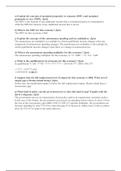
-
a) Explain the concepts of marginal propensity to consume (MPC) and marginal propensity to save (MPS). (2pts)
- Answers • 2 pages • 2020
-
- $8.49
- + learn more
a) Explain the concepts of marginal propensity to consume (MPC) and marginal propensity to save (MPS). (2pts) b) What is the MPC for this economy? (2pts) c) Explain the concepts of the autonomous spending and tax multipliers. (2pts) d) What is the autonomous spending multiplier for this economy? (2pts) e) What is the equilibrium level of income for this economy? (3pts) f) Suppose that the full employment level of output for this economy is 4000. What sort of output gap is Matata island facing? (...
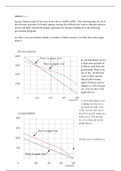
-
George Johnson earns $5 per hour in his job as a truffle sniffer. After allowing time for all of the activities necessary for bodily upkeep, George has 80 hours per week to allocate between leisure and labor. Sketch the budget constraints for George resul
- Class notes • 2 pages • 2020
-
- $3.49
- 1x sold
- + learn more
George Johnson earns $5 per hour in his job as a truffle sniffer. After allowing time for all of the activities necessary for bodily upkeep, George has 80 hours per week to allocate between leisure and labor. Sketch the budget constraints for George resulting from the following government programs.
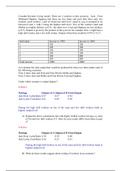
-
Consider Kremers 0-ring model. There are 4 workers in this economy , Jack , Fred, Melbaand Daphne. Suppose that there are two firms and each firm hires only two workers ,each workers , each of whom has skill level equal to q (q is assumed to lie between
- Class notes • 2 pages • 2020
-
- $7.49
- + learn more
Consider Kremers 0-ring model. There are 4 workers in this economy , Jack , Fred, Melbaand Daphne. Suppose that there are two firms and each firm hires only two workers ,each workers , each of whom has skill level equal to q (q is assumed to lie between 0 and 1, with 1 being the highest skill level. Two of the workers (Jack and Melba) are highly skilled ( q=0.9) ; the other two ( Fred and Daphne) are less skilled ( q=0.3). Output is given by the product of the q-levels for example firm 1 might ...
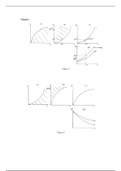
-
a) This is done in panels (a) through (c) of Figure 2. Panel (a) illustrates the producer choice set. Panel (b) inverts this, flipping the axes so that x is on the horizontal and l on the vertical. Finally, (c) is derived from (b) by simply multiplying la
- Essay • 2 pages • 2020
-
- $7.49
- + learn more
a) This is done in panels (a) through (c) of Figure 2. Panel (a) illustrates the producer choice set. Panel (b) inverts this, flipping the axes so that x is on the horizontal and l on the vertical. Finally, (c) is derived from (b) by simply multiplying labor input by w to convert the labor input needs of production into the dollar needs for production. (b) This is done in panel (d) where the MC curve is simply plotting the slope of the cost curve and the average cost curve is simply the total c...

$6.50 for your textbook summary multiplied by 100 fellow students... Do the math: that's a lot of money! Don't be a thief of your own wallet and start uploading yours now. Discover all about earning on Stuvia


